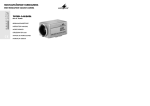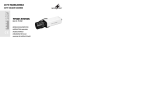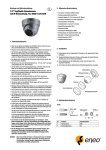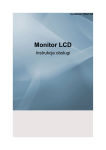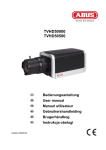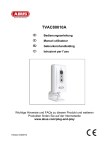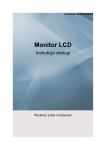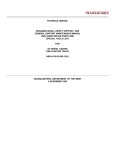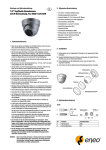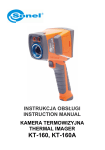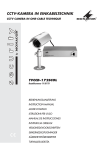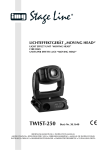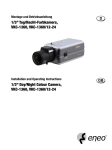Download CCTV-FARBKAMERA TVCCD-462COL
Transcript
CCTV-FARBKAMERA CCTV COLOUR CAMERA TVCCD-462COL Best.-Nr. 19.9330 BEDIENUNGSANLEITUNG INSTRUCTION MANUAL MODE D’EMPLOI ISTRUZIONI PER L’USO MANUAL DE INSTRUCCIONES INSTRUKCJA OBSŁUGI ® D A CH F B CH E Bevor Sie einschalten ... We wish you much pleasure with your new MONACOR unit. Please read these instructions before use. Der deutsche Text beginnt auf Seite 4. The English text starts on page 11. Avant toute utilisation ... I Prima di accendere ... Nous vous remercions d'avoir choisi un appareil MONACOR et vous prions de lire cette notice avant l’utilisation. Vi auguriamo buon divertimento con il Vostro nuovo apparecchio MONACOR. Vi preghiamo di leggere le presenti istruzioni prima dell'uso. La version française commence à la page 18. Il testo italiano comincia a pagina 25. Antes de la conexión ... Le agradecemos el haber adquirido un aparato MONACOR. Por favor lee este manual antes del uso. La versión española se encuentra en la página 32. 2 GB Before you switch on ... Wir wünschen Ihnen viel Spaß mit Ihrem neuen Gerät von MONACOR. Bitte lesen Sie vor dem Gebrauch diese Anleitung. PL Przed Uruchomieniem ... Życzymy Państwu zadowolenia z nowego urządzenia firmy MONACOR. Prosimy o zapoznanie się z niniejsza instrukcją przed przystąpieniem do jego użytkowania. Tekst polski zaczyna się na stronie 39. 1 2 4 5 10 VIDEO OFF OFF AWB 6 BLC ESC ATW LENS DC VIDEO POWER DC LEVEL 11 7 DIGITAL CCD CAMERA 8 12 + 12V GND 3 4 3 ➀ 9 AUTO IRIS ➁ D A Bitte klappen Sie die Seite 3 heraus. Sie sehen dann immer die beschriebenen Bedienelemente und Anschlüsse. CH 1 Übersicht der Bedienelemente und Anschlüsse (Abb. 1 und 2) 1 Schutzkappe 2 C-Mount-Adapterring zum Aufschrauben eines C-Mount-Objektivs 3 Gewindering zum Aufschrauben eines CSMount-Objektivs 4 Inbusschrauben zum Korrigieren des Auflagemaßes für das Objektiv 5 je ein DIP-Schalter für die folgenden Funktionen (siehe dazu Kapitel 7.1): – Gegenlichtkompensation, ein- („BLC“) oder ausgeschaltet („OFF“) – automatischer elektronischer Shutter, ein- („ESC“) oder ausgeschaltet („OFF“) – automatischer Weißabgleich wahlweise Modus „AWB“ oder „ATW“ 6 BNC-Buchse für den Videoausgang 4 7 Betriebsanzeige 8 Klemmen +12V und GND zum Anschluss der Stromversorgung 9 Adapter mit Gewindebuchse [Fotogewinde 6,3 mm (1/ 4")] für die Kameramontage; kann an die Ober- oder Unterseite der Kamera geschraubt werden 10 Umschalter zur Einstellung der Kamera auf den verwendeten AI-Objektivtyp [AI = „Auto Iris“ (automatisch geregelte Blende)] „VIDEO“: bei einem videosignalgeregelten Objektiv „DC“: bei einem gleichspannungsgesteuerten Objektiv (DC-Objektiv) 11 Regler zum Einstellen des Videosignalpegels bei Verwendung eines DC-Objektivs 12 Buchse für den Anschluss eines Objektivs mit automatischer Blendenregelung (AI-Objektiv); die Buchse hat, in Abhängigkeit des Schalters LENS (10), die folgende Pinbelegung: 2 4 1 3 ➂ Buchse AUTO IRIS 2 Pin Schalter LENS in Position „DC“ Schalter LENS in Position „VIDEO“ 1 Dämpfungsspule - Stromversorgung +12 V 2 Dämpfungsspule + nicht belegt 3 Antriebsspule + Ausgang Videosignal 4 Antriebsspule - Masse Wichtige Hinweise für den Gebrauch Die CCTV-Kamera entspricht allen erforderlichen Richtlinien der EU und ist deshalb mit gekennzeichnet. ● Die Kamera ist nur zur Verwendung im Innenbereich geeignet. Bei Außenmontage muss sie in ein wetterfestes Schutzgehäuse eingesetzt werden. ● Schützen Sie die Kamera vor Staub, Feuchtigkeit und Hitze (zulässiger Einsatztemperaturbereich 0 – 40 °C). ● ● ● ● Schützen Sie den CCD-Bildaufnehmer vor Staub und Verschmutzung und berühren Sie ihn auf keinen Fall mit den Fingern. Wenn kein Objektiv aufgeschraubt ist, setzen Sie zum Schutz des CCD-Bildaufnehmers immer die Schutzkappe (1) auf die Objektivfassung der Kamera. Verwenden Sie für die Reinigung nur ein trockenes, weiches Tuch, niemals Chemikalien oder Wasser. Wird die Kamera zweckentfremdet, nicht richtig angeschlossen, falsch bedient oder nicht fachgerecht repariert, kann keine Haftung für daraus resultierende Sach- oder Personenschäden und keine Garantie für die Kamera übernommen werden. D A CH Soll die Kamera endgültig aus dem Betrieb genommen werden, übergeben Sie sie zur umweltgerechten Entsorgung einem örtlichen Recyclingbetrieb. 5 D 3 A Die Farbkamera TVCCD-462COL ist für den Einsatz in Video-Überwachungsanlagen konzipiert. Sie ist mit einer Gegenlichtkompensation und einem automatischen elektronischen Shutter ausgestattet (ein-/ausschaltbar über DIP-Schalter). Außerdem verfügt die Kamera über einen automatischen Weißabgleich mit zwei umschaltbaren Betriebsmodi. Die Kamera ist für die Aufnahme von CSMount- und C-Mount-Objektiven ausgelegt. Es können sowohl Objektive mit automatischer Blendenregelung [AI-Objektive („Auto Iris“), videosignalgeregelt oder gleichspannungsgesteuert] als auch Objektive mit manueller Blendeneinstellung verwendet werden. Ein 4-poliger Anschlussstecker für die Blendensteuerung liegt der Kamera bei. CH Einsatzmöglichkeiten 4 Objektiv 4.1 Kamera auf das Objektiv einstellen Je nach verwendetem Objektivtyp die jeweiligen Schaltereinstellungen durchführen: Objektivtyp Umschalter LENS (10) mittlerer DIPSchalter (5) videosignalgeregeltes Position AI-Objektiv „VIDEO“ Position „OFF“ gleichspannungsgesteuertes AI-Objektiv Position „DC“ Position „OFF“ Objektiv mit fester oder manuell einstellbarer Blende beliebige Position Position „ESC“ 4.2 Objektiv montieren 1) Die Schutzkappe (1) abnehmen. 2) Bei Verwendung eines C-Mount-Objektivs dieses auf den C-Mount-Adapterring (2) schrauben. Bei einem CS-Mount-Objektiv den Adap- 6 terring entfernen und das Objektiv direkt auf den Gewindering (3) schrauben. 3) Bei Verwendung eines AI-Objektivs dieses an die Buchse AUTO IRIS (12) anschließen. Das Anschlusskabel des Objektivs – gemäß der in der Tabelle angegebenen Pin-Belegung für den verwendeten Objektivtyp – an den beiliegenen 4-poligen Stecker löten und diesen in die Buchse stecken. 2 4 1 3 ➃ 4-poliger Stecker (Lötseite) bei einem DC-Objektiv bei einem videosignalgeregelten Objektiv 1 Dämpfungsspule - Stromversorgung +12 V 2 Dämpfungsspule + nicht belegt 3 Antriebsspule + Ausgang Videosignal 4 Antriebsspule - Masse Pin 5 Montage Die Kamera kann auf eine Kamerahalterung (z. B. Halterung der TVH-Serie von MONACOR), auf ein Kamerastativ oder auf einen Schwenk-/ Neigekopf (z. B. VPT-50 von MONACOR) montiert werden. Für die Befestigung besitzt die Kamera auf ihrer Unterseite einen Adapter (9) mit Gewindebuchse [Fotogewinde 6,3 mm (1/ 4")]. Er kann für eine hängende Montage auch an der Kameraoberseite festgeschraubt werden. Bei einer Außenmontage muss die Kamera in ein wetterfestes Schutzgehäuse eingesetzt werden. 6 D A CH Kamera anschließen Die BNC-Buchse VIDEO (6) über ein 75-Ω-Kabel (z. B. BNC-1000 von MONACOR) mit dem Videoeingang des nachfolgenden Geräts (z. B. Monitor, Kamera-Umschalter, Video-Splitter) verbinden. Bei einer Kabellänge von über 100 m sollte ein Videoverstärker zwischen Kamera und Kabel geschaltet werden, um die Kabelverluste auszugleichen. 7 D A CH Zur Stromversorgung ein stabilisiertes Netzgerät (z. B. PS-12CCD von MONACOR) mit einer Ausgangsspannung von 12 V und einer Belastbarkeit von 150 mA an die Klemmen (8) anschließen: Den Pluspol des Netzgeräts an die Klemme +12V und den Minuspol des Netzgeräts an die Klemme GND. 7 Inbetriebnahme Nach dem Anschluss an die Stromversorgung ist die Kamera betriebsbereit. Die Betriebsanzeige POWER (7) leuchtet. 1) Nach dem Einschalten des Monitors die Kamera auf den Überwachungsbereich ausrichten. 2) Am Objektiv die Entfernung einstellen. Bei einem Objektiv mit manuell einstellbarer Blende diese auf optimale Bildwiedergabe (Schärfentiefe und Helligkeit) einstellen. 3) Ist bei korrekt eingestellter Entfernung das Bild unscharf, das Auflagemaß für das Objektiv korrigieren. Dazu mit dem beiliegenden Inbusschlüssel die zwei Inbusschrauben (4) 8 lösen. Durch leichtes Verdrehen des Gewinderings (3) ein scharfes Bild einstellen. Anschließend die Schrauben wieder festziehen. 4) Bei einem Objektiv mit automatischer Blendenregelung (AI-Objektiv) lässt sich der Videosignalpegel für die Blendenregelung korrigieren, falls das Bild zu dunkel oder zu hell erscheint: Wird ein DC-Objektiv verwendet, durch Verdrehen des Reglers DC LEVEL (11) mit einem kleinen Schraubendreher den optimalen Videopegel einstellen. Bei videosignalgeregelten Objektiven befindet sich der Pegelregler für das Videosignal am Objektiv. 7.1 Einstellung der Kamerafunktionen Automatischer elektronischer Shutter (ESC) Bei Verwendung eines Objektivs mit manueller Blendeneinstellung den mittleren DIP-Schalter (5) auf „ESC“ („Electronic Shutter Control“) schieben. In dieser Position ist der automatische elektronische Shutter eingeschaltet: Die Belichtungszeit wird automatisch auf die momentane Helligkeit eingestellt. Die Kamera arbeitet mit Shutterzeiten von 1/50 s bis 1/100 000 s. Bei Verwendung eines AI-Objektivs den Schalter auf „OFF“ stellen. Siehe auch Kapitel 4.1. Gegenlichtkompensation (BLC) Bei Gegenlicht, d. h. Licht, das direkt oder schräg von vorn auf das Objektiv trifft, wird das zu überwachende Objekt unterbelichtet. Dies ist auch der Fall, wenn sich das Objekt vor einem sehr hellen Hintergrund befindet. Die Gegenlichtkompensation (BLC = „Back Light Compensation“) sorgt für eine Aufhellung zu dunkel abgebildeter Objekte in der Bildmitte. Zum Einschalten der Funktion den oberen DIP-Schalter (5) auf Position „BLC“ stellen. Stört kein Gegenlicht, den Schalter auf „OFF“ stellen. lampe) angepasst. Auf diese Weise ist auch bei wechselnden Lichtverhältnissen eine farbechte Wiedergabe gewährleistet. Farbtemperaturen von verschiedenen Lichtquellen Glühlampe 2800 – 3200 K Leuchtstofflampe 4000 – 5000 K Sonnenlicht über 5000 K Tageslicht bei klarem blauen Himmel über 10 000 K D A CH Je nachdem, welche Lichtverhältnisse am Überwachungsort vorliegen, mit dem unteren DIP-Schalter (5) einen der zwei Betriebsmodi für den automatischen Weißabgleich auswählen: Modus „ATW“: Regelbereich von 2500 K bis 9500 K Modus „AWB“: Regelbereich von 2000 K bis 18 000 K Automatischer Weißabgleich Um eine natürliche Farbdarstellung zu erhalten, wird die Kamera über den Weißabgleich automatisch an die Farbtemperatur der verwendeten Lichtquelle (z. B. Leuchtstoff- 9 D 8 A Bildaufnehmer: . . . . . . . CCD-Chip, 8,5 mm (1/ 3") Synchronisation: . . . . . . horizontal 15 625 Hz, vertikal 50 Hz (CCIR) Farbsystem: . . . . . . . . . PAL Bildpunkte: . . . . . . . . . . hor. 752 x vert. 582 Auflösung: . . . . . . . . . . . 470 Linien Mindestbeleuchtung: . . . 0,1 Lux/1 : 1,2 Signal/Rausch-Abstand > 48 dB Autom. elektronischer Shutter (ESC): . . . . . . . . 1/50 bis 1/100 000 s Einstellbare Funktionen: ESC ein/aus, BLC ein/aus, 2 Weißabgleichmodi ATW/AWB CH Technische Daten Videoausgang: . . . . . . . 1 Vss/75 Ω Betriebsspannung: . . . . 12 V /150 mA Einsatztemperatur: . . . . 0 – 40 °C Objektivmontage: . . . . . C-Mount oder CSMount Kameramontage: . . . . . über Fotogewinde [6,3 mm (1/4")] Abmessungen: . . . . . . . 50 × 58 × 68 mm Gewicht: . . . . . . . . . . . . 180 g Änderungen vorbehalten. Diese Bedienungsanleitung ist urheberrechtlich für MONACOR ® INTERNATIONAL GmbH & Co. KG geschützt. Eine Reproduktion für eigene kommerzielle Zwecke – auch auszugsweise – ist untersagt. 10 Please unfold page 3. Then you can always see the operating elements and connections described. 6 BNC jack for the video output GB 7 Power LED 8 Terminals +12 V and GND for connecting the power supply 1 Operating Elements and Connections (fig. 1 and 2) 1 Lens cover 2 C-mount adapter ring for screwing on a C-mount lens 3 Threaded ring for screwing on a CS-mount lens 4 Hexagon socket screws for readjusting the mechanical focus setting for the lens 5 One DIP switch each for the following functions (see chapter 7.1): – backlight compensation, activated (“BLC”) or deactivated (“OFF”) – automatic electronic shutter, activated (“ESC”) or deactivated (“OFF”) – automatic white balance two operating modes available: “AWB” or “ATW” 9 Adapter with thread jack [thread 6.3 mm (1/ 4")] for mounting the camera; to be screwed on the upper or lower side of the camera 10 Selector switch for adjusting the camera to the AI lens type used [AI = “auto iris” (automatically controlled iris)] “VIDEO”: for a lens controlled by video signal “DC”: for a DC controlled lens (DC lens) 11 Control for adjusting the video signal level when using a DC lens 12 Jack for connecting a lens with automatic iris control (AI lens); depending on the switch LENS (10), the jack has the following pin configuration: 2 4 1 3 ➂ Jack AUTO IRIS 11 GB Pin 2 Switch LENS in position “DC” Switch LENS in position “VIDEO” 1 damp - power supply +12 V 2 damp + not connected 3 drive + output of video signal 4 drive - ground Important Notes The CCTV camera corresponds to all required directives of the EU and is therefore marked with . 12 ● The camera is suitable for indoor use only. For outside installation, the camera must be mounted into a weatherproof housing. ● Protect the camera against dust, humidity, and heat (admissible ambient temperature range 0 – 40 °C). ● Protect the CCD image sensor against dust and impurities; never touch it with your fingers. ● If no lens is mounted, always place the lens cover (1) on the lens mount of the camera to protect the CCD image sensor. ● For cleaning only use a dry, soft cloth; never use chemicals or water. ● No guarantee claims for the unit and no liability for any resulting personal damage or material damage will be accepted if the camera is used for other purposes than originally intended, if it is not correctly connected, operated or not repaired in an expert way. If the camera is to be put out of operation definitively, take it to a local recycling plant for a disposal which is not harmful to the environment. 3 Applications The colour camera TVCCD-462COL is designed for application in video surveillance systems. It is equipped with a backlight compensation and an automatic electronic shutter (to be switched on/off via DIP switches). In addition, the camera features an automatic white balance with two operating modes available. The camera is designed for CS-mount and C-mount lenses. It is possible to use either a lens with automatic iris control [AI (“auto iris”) lens, controlled by video signal or DC controlled] or a lens with manual iris control. A 4-pole connector plug for iris control is supplied with the camera. 4 Lens GB 4.1 Adjusting the camera to the lens Set the switches according to the lens type used: Lens type Selector switch Central DIP LENS (10) switch (5) AI lens controlled by video signal position “VIDEO“ position “OFF” DC controlled AI lens position “DC“ position “OFF” Lens with fixed iris or manual iris control any position position “ESC” 4.2 Mounting the lens 1) Remove the lens cover (1). 2) When using a C-mount lens, screw it on the C-mount adapter ring (2). When using a CSmount lens, remove the adapter ring and directly screw the lens on the threaded ring (3). 13 GB 3) When using an AI lens, connect this lens to the jack AUTO IRIS (12). Solder the connection cable of the lens – according to the pin configuration for the lens type used listed in the table – to the supplied 4-pole plug, then connect this plug to the jack. 2 4 1 3 ➃ 14 Mounting The camera can be installed on a camera support (e. g. support of the MONACOR TVH-... series), on a camera stand, or on a pan/tilt head (e. g. MONACOR VPT-50). For this purpose, the lower side of camera is provided with an adapter (9) with thread jack [thread 6.3 mm (1/ 4")]. For suspended installation, this adapter can alternatively be screwed to the upper side of the camera. For outside installation, the camera must be placed in a weatherproof housing. 4-pole jack (solder side) for a DC controlled lens for a lens controlled by video signal 1 damp - power supply +12 V 2 damp + not connected 3 drive + output of video signal 4 drive - ground Pin 5 6 Connecting the Camera Connect the BNC jack VIDEO (6) to the video input of the following unit (e. g. monitor, camera switcher, video splitter) via a 75 Ω cable (e. g. MONACOR BNC-1000). With a cable length exceeding 100 m, a video amplifier should be inserted between the camera and the cable to compensate cable loss. For power supply, connect a regulated power supply unit (e. g. MONACOR PS-12CCD) with an output voltage of 12 V and a current rating of 150 mA to the terminals (8): Connect the positive pole of the power supply unit to the terminal +12V and the negative pole of the power supply unit to the terminal GND. 7 Operation After connecting the camera to the power supply, it is ready for operation. The LED POWER (7) lights up. 1) After switching on the monitor, adjust the camera to the surveillance zone. 2) Adjust the distance on the lens. In case of a lens with manual iris control, adjust the iris to optimum picture reproduction (depth of focus and brightness). 3) If the picture is out of focus despite a correctly adjusted distance, readjust the mechanical focus setting for the lens. For this purpose, release the two hexagon socket screws (4) with the supplied hexagon socket screw key. Adjust a clear picture by slightly turning the threaded ring (3). Then retighten the screws. 4) In case of a lens with automatic iris control (AI lens), the video signal level for the iris control can be readjusted if the picture is too dark or too bright: When using a DC lens, adjust the optimum video level by turning the control DC LEVEL (11) with a small screwdriver. In case of a lens controlled by video signal, the level control for the video signal can be found on the lens. GB 7.1 Adjustment of the camera functions Automatic electronic shutter (ESC) When using a lens with manual iris control, set the central DIP switch (5) to ESC (“electronic shutter control”). In this position, the automatic electronic shutter is switched on: The exposure time is automatically adjusted to the current brightness. The camera operates with shutter times of 1/50 s to 1/100 000 s. When using an AI lens, set the switch to “OFF”. Also see chapter 4.1. 15 GB Backlight compensation (BLC) In case of backlight, i. e. light which hits the lens directly or at an angle from the front, the object to be monitored will be underexposed. This is also the case if the object is in front of a very bright background. The backlight compensation (BLC) will brighten objects in the centre of the picture which are too dark. For activating this function, set the upper DIP switch (5) to the position “BLC”. Without any disturbing backlight, set the switch to “OFF”. Automatic white balance To obtain a natural colour reproduction, the white balance will automatically match the camera to the colour temperature of the light source used (e. g. fluorescent lamp). Thus, a faithful colour reproduction will be ensured even in case of varying lighting conditions. 16 Colour temperatures of various light sources Incandescent lamp 2800 – 3200 K Fluorescent lamp 4000 – 5000 K Sunlight more than 5000 K Daylight in case of a clear blue sky more than 10 000 K According to the lighting conditions at the place of surveillance, select one of the two operating modes for the automatic white balance with the lower DIP switch (5): mode “ATW”: control range from 2500 K to 9500 K mode “AWB”: control range from 2000 K to 18 000 K 8 Specifications Image sensor: . . . . . . . . CCD chip, 8.5 mm (1/ 3") Sychronization: . . . . . . . horizontal 15 625 Hz, vertical 50 Hz (CCIR) Colour system: . . . . . . . PAL Pixels: . . . . . . . . . . . . . . hor. 752 x vert. 582 Resolution: . . . . . . . . . . 470 lines Minimum illumination: . . 0.1 lux/1 : 1.2 S/N ratio: . . . . . . . . . . . > 48 dB Automatic electronic shutter (ESC): . . . . . . . . 1/50 to 1/100 000 s Adjustable functions: . . . ESC on/off, BLC on/off, 2 white balance modes ATW/AWB GB 1 Vpp/75 Ω 12 V /150 mA 0 – 40 °C C-mount or CS-mount via thread [6.3 mm (1/4")] Dimensions: . . . . . . . . . 50 × 58 × 68 mm Weight: . . . . . . . . . . . . . 180 g Video output: . . . . . . . . . Operating voltage: . . . . . Ambient temperature: . . Lens mount: . . . . . . . . . Mounting of camera: . . . Subject to technical modification. All rights reserved by MONACOR ® INTERNATIONAL GmbH & Co. KG. No part of this instruction manual may be reproduced in any form or by any means for any commercial use. 17 F B Ouvrez le présent livret page 3 de manière à visualiser les éléments et branchements. CH 1 Eléments et branchements (schémas 1 et 2) 1 Bouchon d’objectif 2 Anneau adaptateur C-Mount pour visser un objectif à filetage C-Mount 3 Anneau fileté pour visser un objectif à filetage CS-Mount 4 Vis à 6 pans creux pour corriger la précision pour l’objectif 5 Respectivement un interrupteur DIP pour les fonctions suivantes (voir chapitre 7.1) : – compensation du contre-jour, marche (“BLC”) ou arrêt (“OFF”) – obturation électronique automatique, marche (“ESC”) ou arrêt (“OFF”) – compensation automatique du blanc, mode au choix “AWB” ou “ATW” 6 Prise BNC pour la sortie vidéo 18 7 Témoin de fonctionnement 8 Bornes +12 V et GND pour brancher l’alimentation 9 Adaptateur avec prise filetée [filetage 6,3 mm (1/ 4")] pour le montage de la caméra : peut être vissé sur la face supérieure ou inférieure de la caméra. 10 Sélecteur pour régler la caméra sur le type d’objectif AI utilisé (AI : “Auto Iris” : diaphragme à réglage automatique)) “VIDEO” : objectif à commande par signal vidéo “DC” : objectif à commande par tension DC (objectif DC) 11 Réglage du niveau du signal vidéo si vous utilisez un objectif DC 12 Prise pour brancher un objectif avec diaphragme à réglage automatique (objectif AI) : la prise a la configuration suivante selon la position du sélecteur LENS (10) : 2 4 1 3 ➂ prise AUTO IRIS Pin 2 Sélecteur LENS sur position “DC” Sélecteur LENS sur position “VIDEO” 1 bobine atténuation - alimentation +12 V 2 bobine atténuation + non configuré 3 bobine moteur + sortie signal vidéo 4 bobine moteur - masse ● Si aucun objectif n’est vissé, placez toujours le bouchon d’objectif (1) sur la monture d’objectif de la camera pour protéger la puce CCD . ● Pour la nettoyer, utilisez un chiffon sec et doux, en aucun cas de produits chimiques ou d’eau. ● Nous déclinons toute responsabilité en cas de dommages corporels ou matériels résultants si la caméra est utilisée dans un but autre que celui pour lequel elle a été conçue, si elle n’est pas correctement branchée, utilisée ou n’est pas réparée par une personne habilitée, de même, la garantie deviendrait caduque. Conseils importants d’utilisation La caméra CCTV répond à toutes les directives nécessaires de l’Union Européenne et porte donc le symbole . ● La caméra n’est conçue que pour une utilisation en intérieur. Pour un montage en extérieur, elle doit être placée dans un boîtier de protection étanche. ● Protégez la caméra de la poussière, de l’humidité et de la chaleur (plage de température de fonctionnement autorisée : 0 °C à +40 °C). ● Protégez la puce CCD de la poussière et des salissures, en aucun cas, vous ne devez la toucher avec les doigts. F B CH Lorsque la caméra est définitivement retirée du marché, vous devez la déposer dans une usine de recyclage de proximité pour contribuer à son élimination non polluante. 3 Possibilités d’utilisation La caméra couleur TVCCD-462COL est spécialement conçue pour une utilisation dans des installations de surveillance vidéo. Elle est 19 F B CH équipée d’une compensation du contre-jour et d’une obturation électronique automatique (marche/arrêt par interrupteurs DIP). En outre, elle dispose d’une compensation automatique du blanc avec deux modes de fonctionnement commutables. La caméra est conçue pour des objectifs de type C-Mount ou CS-Mount. Il est possible d’utiliser des objectifs à réglage automatique de diaphragme (objectifs AI [“Auto Iris”], à réglage par signal vidéo ou par tension DC) et des objectifs à réglage manuel de diaphragme. Une fiche de branchement 4 pôles pour la commande de diaphragme est livrée avec la caméra. 4 Objectif 4.1 Réglage de la caméra sur l’objectif utilisé Selon le type d’objectif utilisé, effectuez les réglages suivants : Type d’objectif Sélecteur LENS (10) Interrupteur DIP médian (5) Objectif AI à réglage par signal vidéo position “VIDEO” position “OFF” Objectif AI à réglage par tension DC position “DC” position “OFF” Objectif à réglage manuel de diaphragme ou fixe position au choix position “ESC” 4.2 Montage de l’objectif 1) Retirez le bouchon d’objectif (1). 2) Si vous utilisez un objectif C-Mount, vissez-le sur l’anneau adaptateur C-Mount (2). Pour un objectif CS-Mount, retirez l’anneau adapta- 20 teur et vissez directement l’objectif sur l’anneau fileté (3). 3) Si vous utilisez un objectif AI, reliez-le à la prise AUTO IRIS (12). Soudez le cordon de l’objectif à la fiche 4 pôles livrée, selon la configuration de pin mentionnée dans le tableau pour le type d’objectif utilisé, et placez-la dans la prise. 2 4 1 3 ➃ prise 4 pôles (côté à souder) Pin Objectif “DC” Objectif à réglage par signal vidéo 1 bobine atténuation - alimentation +12 V 2 bobine atténuation + non configuré 3 bobine moteur + sortie signal vidéo 4 bobine moteur - masse 5 Montage La caméra peut être montée sur un support de caméra (par exemple support de la série TVH-… de MONACOR), un pied de caméra ou sur un rotor (par exemple VPT-50 de MONACOR). Pour la fixation, la caméra dispose sur la face inférieure d’un adaptateur (9) avec prise filetée [filetage 6,3 mm (1/ 4")]. Il peut être également vissé au choix sur la face supérieure de la caméra pour un montage suspendu. Pour un montage en extérieur, la caméra doit être placée dans un boîtier de protection étanche. 6 F B CH Branchements de la caméra Reliez la prise BNC VIDEO (6) via un cordon 75 Ω (par exemple BNC-1000 de MONACOR) à l’entrée vidéo de l’appareil suivant (par exemple, moniteur, sélecteur de caméra, collecteur vidéo pour affichage simultané). Pour une longueur de câble supérieure à 100 m, il convient de placer un amplificateur vidéo entre la caméra et le câble pour compenser les pertes en ligne. 21 F B CH Pour l’alimentation de la caméra, une alimentation stabilisée (par exemple PS-12CCD de MONACOR) avec une tension de sortie de 12 V et une consommation de 150 mA doit être reliée aux bornes (8) : Reliez le pôle plus de l’alimentation à la borne +12V et le pôle moins de l’alimentation à la borne GND. 7 Fonctionnement Une fois le branchement à l’alimentation effectué, la caméra est prête à fonctionner. Le témoin de fonctionnement POWER (7) brille. 1) Une fois le moniteur allumé, dirigez la caméra sur la zone à surveiller. 2) Sur l’objectif, réglez la distance. Pour un objectif à diaphragme à réglage manuel, réglez le diaphragme pour une restitution optimale des images (profondeur de champ et luminosité). 3) Si pour une distance correctement réglée, l’image n’est pas nette, corrigez la précision pour l’objectif. Pour ce faire, avec la clé livrée, desserrez les deux vis à 6 pans creux (4). En 22 tournant légèrement l’anneau fileté (3), réglez une image nette. Revissez ensuite les vis. 4) Pour un objectif à commande automatique de diaphragme (objectif AI), le niveau du signal vidéo pour le réglage du diaphragme peut être corrigé si l’image est trop sombre ou trop claire : Si un objectif DC est utilisé, réglez le niveau vidéo optimal en tournant le réglage DC LEVEL (11) avec un petit tournevis. Pour des objectifs à commande par signal vidéo, le réglage de niveau pour le signal vidéo se trouve sur l’objectif. 7.1 Réglage des fonctions de la caméra Obturation électronique automatique (ESC) Si vous utilisez un objectif à réglage manuel de diaphragme, mettez l’interrupteur DIP du milieu (5) sur “ESC” (“Electronic Shutter Control”). Dans cette position, l’obturation électronique automatique est allumée : la durée d’exposition est réglée automatiquement sur la luminosité du moment. La caméra fonc- tionne avec des durées d’obturation de 1/50 s – 1/100 000 s. Si vous utilisez un objectif AI, mettez l’interrupteur sur “OFF”. Voir également chapitre 4.1. Compensation du contre-jour (BLC) En cas de contre-jour, c’est-à-dire lorsque la lumière touche l’objectif directement ou en oblique par l’avant, l’objet à surveiller est sous-exposé. C’est aussi le cas lorsque l’objet se trouve devant un fond très clair. La compensation du contre-jour (BLC : “Back Light Compensation”) génère un éclaircissement pour les objets affichés trop sombres dans la partie centrale de l’image. Pour allumer cette fonction, mettez l’interrupteur DIP supérieur (5) sur la position “BLC”. Si aucun contre-jour perturbateur n’est présent, mettez l’interrupteur sur “OFF”. neuse utilisée (par exemple lampe fluorescente). De cette façon, on garantit une restitution fidèle des couleurs même en cas de conditions d’éclairage changeantes. F B CH Températures de couleur de diverses sources lumineuses Lampe à incandescence 2800 – 3200 K Lampe fluorescente 4000 – 5000 K Lumière du soleil au-dessus de 5000 K Lumière du jour avec ciel clair et bleu au-dessus de 10 000 K Selon les conditions d’éclairage présentes sur le lieu de surveillance, sélectionnez avec l’interrupteur DIP inférieur (5) un des deux modes de fonctionnement pour la compensation automatique du blanc : mode “ATW” : plage de réglage de 2500 K à 9500 K mode “AWB” : plage de réglage de 2000 K à 18 000 K Compensation automatique du blanc Pour obtenir une reproduction naturelle des couleurs, la caméra est adaptée via la compensation du blanc, automatiquement à la température de couleur de la source lumi- 23 F 8 B Système : . . . . . . . . . . . puce CCD, 8,5 mm (1/ 3") Synchronisation : . . . . . horizontal 15 625 Hz, vertical 50 Hz (CCIR) Système couleur : . . . . . PAL Nombre de points : . . . . hor. 752 x vert. 582 Résolution : . . . . . . . . . . 470 lignes Luminosité minimale : . . 0,1 lux/1 : 1,2 Rapport signal/bruit : . . > 48 dB Obturation électronique automatique (ESC) : . . . 1/50 à 1/100 000 s Fonctions réglables : . . . ESC marche/arrêt BLC marche/arrêt 2 modes de compensation du blanc ATW/AWB CH Caractéristiques techniques Sortie vidéo : . . . . . . . . . 1 Vcc/75 Ω Tension fonctionnement : 12 V /150 mA Température fonc. : . . . . 0 – 40 °C Montage objectif : . . . . . C-Mount ou CS-Mount Montage caméra : . . . . . par filetage [6,3 mm (1/ 4")] Dimensions : . . . . . . . . . 50 × 58 × 68 mm Poids : . . . . . . . . . . . . . . 180 g Tout droit de modification réservé. Notice d'utilisation protégée par le copyright de MONACOR ® INTERNATIONAL GmbH & Co. KG. Toute reproduction même partielle à des fins commerciales est interdite. 24 Vi preghiamo di aprire completamente la pagina 3. Così vedrete sempre gli elementi di comando e i collegamenti descritti. 6 Presa BNC per l’uscita video I 7 Spia di funzionamento 8 Morsetti +12 V e GND per il collegamento dell’alimentazione 1 Elementi di comando e collegamenti (figg. 1 e 2) 1 Cappuccio protettivo 2 Anello adattatore C-Mount per avvitare un obiettivo C-Mount 9 Adattatore con presa filettata [tipo macchina fotografica 6,3 mm (1/ 4")] per il montaggio della telecamera; può essere avvitato sul lato superiore o inferiore della telecamera 3 Anello filettato per avvitare un obiettivo CSMount 10 Selettore per regolare la telecamera secondo il tipo di obiettivo AI [AI = “Auto Iris” (diaframma regolato automaticamente)] 4 Viti ad esagono cavo per correggere la posizione dell’obiettivo “VIDEO”: con obiettivo comandato dal segnale video 5 Dip-switch per le seguenti funzioni (vedi anche cap. 7.1): – compensazione della controluce attivata (“BLC”) o disattivata (“OFF”) – shutter elettronico automatico attivato (“ESC”) o disattivato (“OFF”) – bilanciamento automatico del bianco a scelta modalità “AWB” o “ATW” “DC”: con obiettivo comandato dalla tensione continua (obiettivo DC) 11 Regolatore per impostare il livello del segnale video con l’uso di un obiettivo DC 12 Presa per il collegamento di un obiettivo con regolazione automatica del diaframma (obiettivo AI); i contatti dei pin sono, a seconda della posizione del selettore LENS (10), i seguenti: 25 I 1 3 2 4 Pin 2 ➂ Proteggere il sensore ottico CCD dalla polvere e dallo sporco; non toccarlo in nessun caso con le dita. ● Se non è montato nessun obiettivo inserire sempre il cappuccio protettivo (1) sul portaobiettivo per proteggere il sensore ottico. ● Per la pulizia usare solo un panno asciutto, morbido, mai prodotti chimici o acqua. ● Nel caso d’uso improprio, di collegamenti sbagliati, di impiego scorretto o di riparazione non a regola d’arte della telecamera, non si assume nessuna responsabilità per eventuali danni consequenziali a persone o a cose e non si assume nessun garanzia per la telecamera. Presa AUTO IRIS Selettore LENS in posizione “DC” Selettore LENS in posizione “VIDEO” 1 bobina di attenuazione - alimentazione +12 V 2 bobina di attenuazione + libero 3 bobina di azionamento + uscita segnale video 4 bobina di azionamento - massa Avvertenze importanti per l’uso La telecamera CCTV è conforme a tutte le direttive richieste dell’UE e pertanto porta la sigla . 26 ● ● La telecamera è adatta solo per l’uso all’interno di locali. Nel caso di montaggio all’esterno deve essere montata in una custodia resistente alle intemperie. ● Proteggere la telecamera dalla polvere, dall’umidità e dal calore (temperatura d’impiego ammessa 0 – 40 °C). Se si desidera eliminare la telecamera definitivamente, consegnarla per lo smaltimento ad un’istituzione locale per il riciclaggio. 3 Possibilità d’impiego La telecamera a colori TVCCD-462COL è stata realizzata per l’impiego in impianti di sorveglianza video. È equipaggiata con una compensazione della controluce e con un otturatore elettronico automatico (dis/attivabile tramite dip-switch). La telecamera dispone inoltre di bilanciamento automatico del bianco con due modalità di funzionamento. Sulla telecamera si possono montare sia obiettivo CS-mount che C-mount. Gli obiettivi possono essere usati con regolazione automatica del diaframma [obiettivi AI (“Auto Iris”), con regolazione dal segnale video o dalla tensione continua] oppure con regolazione manuale del diaframma. Un connettore a 4 poli per comandare il diaframma è in dotazione. 4 Obiettivo I 4.1 Regolare la telecamera a seconda dell’obiettivo Eseguire le diverse impostazioni dei selettori a seconda del tipo di obiettivo usato: Tipo di obiettivo Selettore LENS (10) DIP-switch centrale (5) Obiettivo AI comandato dal segnale video posizione “VIDEO“ posizione “OFF” Obiettivo AI comandato dalla tensione continua posizione “DC“ posizione “OFF” Obiettivo con diaqualsiasi framma fisso o manuale posizione posizione “ESC” 4.2 Montaggio dell’obiettivo 1) Togliere il cappuccio protettivo (1). 2) Usando un obiettivo C-mount, avvitarlo sull’anello adattatore C-mount (2). Nel caso di un obiettivo CS-mount, togliere l’anello adatta- 27 I tore e avvitare l’obiettivo direttamente sull’anello filettato (3). 3) Se si usa un obiettivo AI, collegarlo con la presa AUTO IRIS (12). Saldare il cavo di collegamento dell’obiettivo al connettore a 4 poli in dotazione – seguendo le indicazioni della tabella dei contatti in relazione al tipo di obiettivo – e inserire il connettore nella presa. 2 4 1 3 ➃ Pin 28 con obiettivo DC Connettore a 4 poli (lato a saldare) con obiettivo regolato dal segnale video 1 bobina di attenuazione - alimentazione +12 V 2 bobina di attenuazione + libero 3 bobina di azionamento + uscita segnale video 4 bobina di azionamento - massa 5 Montaggio La telecamera può essere montata su un apposito supporto (p. es. della serie TVH della MONACOR), su uno stativo per telecamere oppure su una testa orientabile/ basculabile (p. es. VPT-50 della MONACOR). Per il fissaggio, sul lato inferiore si trova un adattatore (9) con presa filettata [tipo macchina fotografica 6,3 mm (1/ 4")]. Per il montaggio sospeso, l’adattatore può essere avvitato anche sul lato superiore della telecamera. Nel caso di montaggio all’esterno, la telecamera deve essere montata in una custodia protettiva resistente alle intemperie. 6 Collegamento della telecamera Collegare la presa BNC VIDEO (6) con l’ingresso video dell’apparecchio a valle (p. es. monitor, selettore per telecamere, video-splitter) servendosi di un cavo 75 Ω (p. es. BNC-1000 della MONACOR). Se il cavo supera i 100 metri di lunghezza, è opportuno inserire un amplificatore video fra telecamera e cavo per compensare le perdite dovute al cavo. Per l’alimentazione, collegare ai morsetti (8) un alimentatore stabilizzato (p. es. PS-12CCD della MONACOR) con tensione d’uscita di 12 V e con potenza di 150 mA: il positivo dell’alimentatore con il morsetto +12 V e il negativo dell’alimentatore con il morsetto GND. 7 Messa in funzione Dopo il collegamento dell’alimentazione, la telecamera è pronta per l’uso. La spia di funzionamento POWER (7) è accesa. 1) Dopo l’accensione del monitor orientare la telecamera verso la zona da sorvegliare. 2) Impostare la distanza sull’obiettivo. Nel caso di un obiettivo con diaframma a regolazione manuale impostare il diaframma per una riproduzione ottimale dell’immagine (profondità di campo e luminosità). 3) Se con distanza impostata correttamente, l’immagine non è a fuoco, occorre correggere la posizione del obiettivo. Per fare ciò allentare le due viti esagonali cavi (4) per mezzo dell’apposita chiave in dotazione. Mettere a fuoco l’immagine girando leggermente l’anello filettato (3). Quindi stringere di nuovo le viti. I 4) Nel caso di un obiettivo con regolazione automatica del diaframma (obiettivo AI), è possibile correggere il livello del segnale video per regolare il diaframma, se l’immagine appare troppo scura o troppo chiara: con un obiettivo DC, impostare il livello video ottimale girando il regolatore DC LEVEL (11) per mezzo di un piccolo cacciavite con un obiettivo comandato dal segnale video, il regolatore del livello si trova sull’obiettivo stesso. 7.1 Impostazione delle funzioni della telecamera Shutter elettronico automatico (ESC) Se si usa un obiettivo con regolazione manuale del diaframma, spostare il dip-switch centrale (5) su “ESC” (“Electronic Shutter Control”). In questa posizione, lo shutter elettronico automatico è attivato: il tempo di 29 I esposizione viene regolato automaticamente secondo la luminosità presente. I tempi di esposizione vanno da 1/50 s bis 1/100 000 s. Se si usa un obiettivo AI, mettere lo switch su “OFF”. Vedi anche capitolo 4.1. Compensazione della controluce (BLC) Nel caso di controluce, cioè di luce che colpisce l’obiettivo direttamente o di sbieco dal davanti, l’oggetto da sorvegliare sarà sottoesposto. Lo stesso succede se l’oggetto si trova davanti a uno sfondo molto chiaro. La compensazione della controluce (BLC = “Back Light Compensation”) provvede a rendere più chiare le parti scure nel centro dell’immagine. Per attivare la funzione, portare il dip-switch superiore (5) su “BLC”. Nel caso di assenza di controluce mettere lo switch su “OFF”. Bilanciamento automatico del bianco Per ottenere delle immagini con colori naturali, la telecamera si adatta automaticamente alla temperatura cromatica della sorgente di luce (p. es. lampada fluorescente) per mezzo del bilanciamento del bianco. In questo modo, 30 anche con condizioni di luce variabili sono garantiti colori naturali dell’immagine. Temperature cromatiche di differenti sorgenti di luce Lampada ad incandescenza 2800 – 3200 K Lampada fluorescente 4000 – 5000 K Luce del sole oltre 5000 K Luce del giorno con cielo sereno oltre 10 000 K Selezionare con il dip-switch inferiore (5) una delle due modalità di bilanciamento del bianco a seconda delle condizioni di luce presenti sul luogo da sorvegliare: Modalità “ATW”: Campo di regolazione da 2500 K a 9500 K Modalità “AWB”: Campo di regolazione da 2000 K a 18 000 K 8 Dati tecnici Sensore ottico: . . . . . . . chip CCD, 8,5 mm (1/ 3") Sincronizzazione: . . . . . orizzontale 15 625 Hz, verticale 50 Hz (CCIR) Sistema di colore: . . . . . PAL Pixel: . . . . . . . . . . . . . . . orizz. 752 x vert. 582 Risoluzione: . . . . . . . . . 470 linee Illuminazione minima: . . 0,1 Lux/1 : 1,2 Rapporto S/R: . . . . . . . . > 48 dB Shutter elettronico automatica (ESC): . . . . . 1/50 a 1/100 000 s Funzioni impostabili: . . . ESC on/off, BLC on/off, 2 mod. di bilanciamento del bianco ATW/AWB I 1 Vpp/75 Ω 12 V /150 mA 0 – 40 °C C-Mount o CS-Mount tramite filettatura tipo macchina fotografica [6,3 mm (1/ 4")] Dimensioni: . . . . . . . . . . 50 × 58 × 68 mm Peso: . . . . . . . . . . . . . . . 180 g Uscita video: . . . . . . . . . Tensione d’esercizio: . . . Temperatura d’esercizio: Montaggio obiettivo: . . . Montaggio telecamera: . Con riserva di modifiche tecniche. La MONACOR ® INTERNATIONAL GmbH & Co. KG si riserva ogni diritto di elaborazione in qualsiasi forma delle presenti istruzioni per l’uso. La riproduzione – anche parziale – per propri scopi commerciali è vietata. 31 E Abrir el presente libro página 3 de manera a visualizar los elementos y las conexiones. 1 Elementos y conexiones (esquema 1 y 2) 1 Tapa de protección 2 Anilla adaptadora C-Mount para atornillar un objetivo con rosca C-Mount 3 Anilla enroscada para atornillar un objetivo con rosca CS-Mount 4 Tornillos de cabeza con hexágono interior para corregir la precisión del objetivo 5 Respectivamente un interruptor DIP para las funciones siguientes (vea capítulo 7.1): – compensación de la contraluz, conectado (“BLC”) o desconectado (“OFF”) – obturación electrónica automática, conectado (“ESC”) o desconectado (“OFF”) – compensación automática del blanco, modo a elegir “AWB” o “ATW” 6 Toma BNC para la salida video 32 7 Testigo de funcionamiento 8 Bornes +12V y GND para conectar la alimentación 9 Adaptador con toma enroscada [rosca 6,3 mm (1/ 4")] para el montaje de la cámara; puede atornillarla en la parte superior o en la parte inferior de la cámara 10 Selector para regular la cámara en el tipo de objetivo AI utilizado [AI = “Auto Iris” (diafragma con reglaje automático)] “VIDEO”: en caso de un objetivo con reglaje por señal video “DC”: en caso de un objetivo con control por tensión DC (objetivo DC) 11 Reglaje del nivel de la señal video si utiliza un objetivo DC 12 Toma para conectar un objetivo con reglaje automático de diafragma (objetivo AI); la toma tiene la configuración siguiente según la posición del selector LENS (10): 2 4 1 3 ➂ Toma AUTO IRIS Pin 2 Selector LENS en posición “DC” Selector LENS en posición “VIDEO” 1 bobina atenuación - alimentación +12 V 2 bobina atenuación + no configurada 3 bobina motor + salida señal video 4 bobina motor - masa Notas importantes La cámara corresponde a todas las Directivas requeridas de la UE y por ello está marcada con . ● La cámara está fabricada únicamente para una utilización en interior. Para un montaje en exterior, debe colocarla en una caja de protección resistente a la intemperie. ● Protéjela del polvo, de la humedad y del calor (temperatura de funcionamiento autorizada: 0 °C a +40 °C). ● Proteja el sensor CCD del polvo y de las salpicaduras, en ningún caso, no la manipule con los dedos. ● ● ● Si ningún objetivo está atornillado, coloque siempre la tapa de protección (1) sobre el zócalo del objetivo de la cámara para proteger el sensor CCD. Para limpiar la cámara, utilice un trapo seco y suave, en ningún caso productos químicos o agua. Rechazamos cualquier responsabilidad en caso de daños corporales o materiales que resultarían de una utilización inadecuada y diferente de la utilización para la cual la cámara ha sido fabricada, si no está correctamente conectada o reparada por una persona especializada, además por todos estos mismos motivos el aparato carecería de todo tipo de garantía. E Cuando la cámara está definidamente sacada del servicio, debe depositarla en una fábrica de reciclaje de proximidad para contribuir a una eliminación no contaminante. 33 E 3 Posibilidades de utilización La cámara color TVCCD-462COL está especialmente fabricada para una utilización en instalaciones de vigilancia video. Dispone de la compensación de la contraluz, de una obturación electrónica automática (ON/OFF por interruptores DIP). También dispone de una compensación automática del blanco con dos modos de funcionamiento conmutables. La cámara está fabricada para objetivos de tipo C-Mount o CS-Mount. Es posible utilizar objetivos con reglaje automático de diafragma [objetivo AI (“Auto Iris”), con reglaje por señal video o con control por tensión DC] así como objetivos con reglaje manual de diafragma. Una toma de conexión 4 polos para el control de diafragma está entregada con la cámara. 4 Objetivo 4.1 Reglaje de la cámara según el objetivo Según el tipo de objetivo utilizado, efectué los reglajes siguientes: Tipo objetivo Selector (10) LENS Interruptor DIP (5), del medio Objetivo AI con reglaje por señal video posición “VIDEO” posición “OFF” Objetivo AI con control por tensión DC posición “DC” posición “OFF” Objetivo con diafragma a reglaje manual o fijo posición indiferente posición “ESC” 4.2 Montaje del objetivo 1) Saque la tapa de protección (1). 2) Si utiliza un objetivo C-Mount, atorníllelo sobre la anilla adaptadora C-Mount (2). Para un objetivo CS-Mount, saque la anilla adapta- 34 dora y atornille directamente el objetivo sobre la anilla enroscada (3). 3) Si utiliza un objetivo AI, conéctelo con la toma AUTO IRIS (12). Soldar el cable del objetivo con la toma 4 polos entregada, según la configuración de pin mencionada en la tabéela para el tipo de objetivo utilizado, y colóquelo en la toma AUTO IRIS. 2 4 1 3 ➃ en caso de un Pin objetivo “DC” Toma 4 polos (lado a soldar) en caso de un objetivo con reglaje por señal video 1 bobina atenuación - alimentación +12 V 2 bobina atenuación + no configurada 3 bobina motor + salida señal video 4 bobina motor - masa 5 Montaje E Puede montar la cámara sobre un soporte de cámara (p. ej. los soportes de la serie TVH-… de MONACOR), sobre un pie de cámara o sobre un rotor (p. ej. VPT-50 de MONACOR). Para la fijación, la cámara dispone en la parte inferior de un adaptador (9) con una toma enroscada [rosca 6,3 mm (1/ 4")]. También puede atornillarlo en la parte superior de la cámara para un montaje colgado. Para un montaje en exterior, debe colocar la cámara en una caja de protección resistente a la intemperie. 6 Conexiones de la cámara Conecte la toma BNC VIDEO (6) vía un cable 75 Ω (por ejemplo BNC-1000 de MONACOR) con la entrada video del aparato siguiente (por ejemplo, monitor, selector de cámara, colector video para visualización simultánea). Para una longitud de cable superior a 100 m, conviene colocar un amplificador video entre la cámara y el cable para compasar las perdidas en línea. 35 E Para la alimentación de la cámara, una alimentación estabilizada (p. ej. PS-12CCD de MONACOR) con una tensión de salida de 12 V y una capacidad de corriente de 150 mA debe conectarse a los bornes (8): conecte el polo positivo de la alimentación al borne +12V y el polo negativo de la alimentación al borne GND. 7 Funcionamiento Una vez la conexión a la alimentación efectuada, la cámara está lista a funcionar. El testigo de funcionamiento POWER (7) brilla. 1) Una vez el monitor conectado, dirija la cámara hacia la zona de vigilancia. 2) En el objetivo, regule la distancia. Para un objetivo con diafragma a reglaje manual, regule el diafragma para una restitución óptima de las imágenes (profundidad de campo y luminosidad). 3) Si para una distancia correctamente regulada, la imagen no es nítida, corrija la precisión del objetivo. Para efectuar esta manipulación, con la llave entregada, desatornille los 36 dos tornillos de cabeza con hexágono interior (4). Girando ligeramente la anilla enroscada (3), regule una imagen nítida. Atornille de nuevo los tornillos. 4) Para un objetivo con reglaje automático de diafragma (objetivo AI), el nivel de la señal video para el reglaje del diafragma puede corregirse si la imagen es demasiada oscura o demasiada clara: Si utiliza un objetivo DC, regule el nivel video óptimo girando el reglaje DC LEVEL (11) con un pequeño atornillador. Para objetivos con reglaje por señal video, el reglaje de nivel para la señal video está en el objetivo. 7.1 Reglaje de las funciones de la cámara Obturación electrónica automática (ESC) Si utiliza un objetivo con reglaje manual de diafragma, ponga el interruptor DIP del medio (5) en “ESC” (“Electronic Shutter Control”). En esta posición, la obturación electrónica automática está conectada: la duración de exposición está regulada automáticamente en la luminosidad del momento. La cámara funciona con duraciones de obturación de 1/50 s – 1/100 000 s. Si utiliza un objetivo AI, ponga el interruptor en “OFF”. Vea también capítulo 4.1. Compensación de la contraluz (BLC) En caso de contraluz, es decir, cuando la luz toca el objetivo directamente o en obliga por la parte delantera, el objeto a vigilar está subexpuesto. También es el caso cuando el objeto está delante de un fondo muy claro. La compensación de la contraluz (BLC: “Back Light Compensation”) genera un esclarecimiento para los objetos demasiados oscuros en la parte central de la imagen. Para conectar esta función, ponga el interruptor DIP superior (5) en la posición “BLC”. Si no hay ningún tipo de contraluz, ponga el interruptor en “OFF”. peratura del color de la fuente de luz utilizada (por ejemplo lámpara fluorescente). De esta manera, se garantiza una restitución sólida de los colores mismo en caso de cambios de relaciones luminosas. E Temperaturas de color de diversas fuentes de luz Lámpara incandescente 2800 – 3200 K Lámpara fluorescente 4000 – 5000 K Luz del sol por encima de 5000 K Luz del día con cielo claro y azul por encima de 10 000 K Según el tipo de relaciones luminosas presentes en el lugar de vigilancia, seleccione con el interruptor DIP inferior (5) uno de los dos modos de funcionamiento para la compensación automática del blanco: modo “ATW”: zona de reglaje de 2500 K a 9500 K modo “AWB”: zona de reglaje de 2000 K a 18 000 K Compensación automática del blanco Para obtener una reproducción natural de los colores, la cámara se adapta vía la compensación del blanco, automáticamente a la tem- 37 E 8 Características técnicas Sensor de imagen: . . . . chip CCD, 8,5 mm (1/ 3") Sincronización: . . . . . . . horizontal 15 625 Hz, vertical 50 Hz (CCIR) Sistema de color: . . . . . PAL Cantidad de puntos: . . . hor. 752 x vert. 582 Resolución: . . . . . . . . . . 470 líneas Luminosidad mínima: . . 0,1 lux/1 : 1,2 Relación señal/ruido: . . > 48 dB Obturación electrónica automática (ESC): . . . . . 1/50 a 1/100 000 s Funciones regulables: . . ESC ON/OFF BLC ON/OFF 2 modos de compensación del blanco ATW/AWB Salida video: . . . . . . . . Tensión funcionamiento: . . . . . . Temperatura func.: . . . . Montaje objetivo: . . . . . Montaje cámara: . . . . . 1 Vcc/75 Ω 12 V /150 mA 0 – 40 °C C-Mount o CS-Mount vía rosca [6,3 mm (1/4")] Dimensiones: . . . . . . . . 50 × 58 × 68 mm Peso: . . . . . . . . . . . . . . 180 g Todo derecho de modificación reservado. Manual de instrucciones protegido por el copyright de MONACOR ® INTERNATIONAL GmbH & Co. KG. Toda reproducción mismo parcial con fines comerciales está prohibida. 38 Proszę otworzyć niniejszą instrukcję na stronie 3. Dzięki temu będą Państwo mogli obserwować opisywane elementy sterujące i połączenia. 1 Elementy sterujące i połączenia (rys.1 i 2) 1 Osłona obiektywu 2 Pierścień mocujący typu C do montowania obiektywu przystosowanego do tego obiektywu 3 Pierścień mocujący obiektywu typu CS 4 Śruby regulacji ręcznej ogniskowej obiektywu 5 Przełączniki DIP. Każdy do włączania, lub wyłączania poszczególnych funkcji (patrz rozdz. 7.1): – kompensata jasnego tła, włączona (“BLC”), lub wyłączona (“OFF”) – automatyczna migawka, włączona (“ESC”), lub wyłączona (“OFF”) – automatyczna regulacji bieli możliwe dwa tryby pracy: “AWB”, lub “ATW” 6 Gniazdo wyjścia video BNC 7 Dioda wskaźnika zasilania 8 Terminale +12V i uziemienia GND do podłączenia zasilania 9 Mocowanie kamery [śruba 6,3 mm (1/ 4")]; możliwość instalacji u dołu, lub na górze kamery 10 Przełącznik trybu pracy z odpowiednim obiektywem AI [AI = “auto iris” (automatyczna przesłona)] “VIDEO”: dla obiektywów regulowanych sygnałem video “DC”: dla obiektywów sterowanych napięciem (obiektyw DC) 11 Regulator poziomu sygnału video podczas używania obiektywu DC 12 Gniazdo podłączania obiektywu z automatyczną przesłoną (obiektyw AI); w zależności od ustawienia przełącznika LENS (10), gniazdo posiada następującą konfigurację biegunów: 2 4 1 3 ➂ PL Gniazdo AUTO IRIS 39 PL Pin 2 Przełącznik LENS w pozycji “DC” Przełącznik LENS w pozycji “VIDEO” 1 damp - zasilanie +12 V 2 damp + brak funkcji 3 drive + wyjście sygnału video 4 drive - masa Bezpieczeństwo użytkowania Urządzenie spełnia wymogi dyrektyw obowiązujących w Unii Europejskiej, posiada więc oznaczenie . ● Urządzenie przeznaczone jest do użytku tylko wewnątrz pomieszczeń. W przypadku instalacji na zewnątrz, kamera musi być umieszczona w wodoszczelnej obudowie. ● Należy chronić je przed kurzem, wilgocią oraz wysoką temperaturą (dopuszczalna temperatura otoczenia pracy wynosi 0 – 40 °C). 40 ● Należy chronić sensor CCD przed kurzem oraz zanieczyszczeniami; nie wolno dotykać go palcami. ● Jeżeli do kamery nie jest zamocowany obiektyw należy zasłonić otwór pokrywą ochronną (1) w celu ochrony sensora CCD. ● Do czyszczenia używać jedynie suchego, czystego kawałka materiału. Nie używać środków chemicznych, ani wody. ● Dostawca oraz producent nie ponoszą odpowiedzialności za ewentualnie wynikłe szkody materialne lub uszczerbki na zdrowiu, jeśli urządzenie było używane niezgodnie z przeznaczeniem, zostało niepoprawnie zainstalowane lub obsługiwane oraz było poddawane naprawom przez nieautoryzowany personel. Jeżeli urządzenie nie będzie już nigdy więcej używane, wskazane jest przekazanie go do miejsca utylizacji odpadów, aby zostało utylizowane bez szkody dla środowiska. 3 Zastosowania Kamera kolorowa TVCCD-462COL nadaje się do stosowania w systemach monitorowania. Wyposażona jest w funkcje kompensaty jasnego tła oraz automatyczną migawkę (włączane za pomocą przełączników on/off). Poza tym kamera wyposażona jest w funkcją automatycznej regulacji bieli z dostępnymi dwoma możliwymi ustawieniami. Kamera współpracuje z obiektywami wyposażonymi w mocowania typu C i CS. Można używać zarówno obiektywów z automatyczną [obiektywy AI (“auto iris”), sterowane sygnałem video, lub napięciowo], jak i ręczną regulacją przesłony. Czterobiegunowy wtyk do kontroli przesłony znajduje się w zestawie. 4 Obiektyw PL 4.1 Dostosowywanie kamery do obiektywu Ustawić przełączniki zgodnie ze stosowanym typem obiektywu: Typ obiektywu Przełącznik LENS (10) Środkowy przełącznik (5) Obiektywy AI sterowane sygnałem video pozycja “VIDEO” pozycja “OFF” Obiektywy AI sterowane napięciowo pozycja “DC” pozycja “OFF” Obiektywy sterowane ręcznie, lub o stałej ogniskowej dowolna pozycja pozycja “ESC” 4.2 Montowanie obiektywu 1) Usunąć osłonę obiektywu (1). 2) W przypadku obiektywu typu C, należy dokręcić go do pierścienia (2). W przypadku obiektywu typu CS, należy usunąć pierścień 41 PL (2) dokręcić obiektyw bezpośrednio do pierścienia z gwintem (3). 3) W przypadku stosowania obiektywów AI, należy podłączyć go do gniazda AUTO IRIS (12). Przylutować przewód połączeniowy obiektywu do wtyku kamery – zgodnie z poniższym schematem. 2 4 1 3 ➃ Pin 42 5 Montaż Kamera może być montowana na uchwycie kamery (np.: z serii MONACOR TV-…), statywie, lub obrotowej głowicy (np.: z serii MONACOR VPT-50). Do tego celu dolna część kamery wyposażona jest w mocowanie (9) z otworem gwintowanym [śruba 6,3 mm (1/ 4")]. Aby podwiesić kamerę należy przykręcić mocowanie do górnej części kamery. Jeżeli kamera ma pracować na zewnątrz, musi być osłonięta przed działaniem czynników atmosferycznych za pomocą osłony wodoodpornej. Gniazdo czterobiegunowe (od strony lutów) Obiektywy kontro- Obiektyw kontrolowane lowane napięciowo sygnałem video 1 damp - zasilanie +12 V 2 damp + brak funkcji 3 drive + wyjście sygnału video 4 drive - masa 6 Podłączanie Kamery Podłączyć gniazdo BNC VIDEO (6) z wejściem video następnego urządzenia (np.: monitorem, przełącznikiem kamer, multiplekserem) przy pomocy kabla 75 Ω (np.: MONACOR BNC-1000). Jeżeli przewód połączeniowy przekracza 100 m, należy zastosować wzmacniacz sygnału video w celu zrekompensowania strat sygnału. W celu zasilenia kamery należy podłączyć do niej zasilacz o napięciu wyjściowym 12 V i natężeniu 150 mA (np.: MONACOR PS-12CCD): biegun dodatni zasilacza podłączyć z terminalem +12V, a biegun ujemny z terminalem GND. 7 Działanie Po podłączeniu kamery do zasilacza jest ona gotowa do pracy. Dioda wskaźnika zasilania POWER (7) zaświeca się. 1) Po włączeniu monitora nakierować kamerę na monitorowany obszar. 2) Ustawić obiektyw na odpowiedni dystans. W przypadku obiektywów z regulacją ręczną, ustawić przesłonę tak, aby obraz był optymalny (głębia ostrości i jasność). 3) Jeżeli obraz jest nieostry mimo prawidłowo ustawionego dystansu należy zmienić mechaniczne ustawienie ostrości obiektywu. W tym celu należy poluzować dwie śruby mocujące (4) przy pomocy załączonego śrubokręta. Wyregulować obraz poprzez deli- katne obroty pierścienia (3). Następnie dokręcić śruby. PL 4) W przypadku obiektywów z automatyczną regulacją przesłony (obiektywy AI), poziom sygnału video może być regulowany, jeżeli obraz jest zbyt ciemny, lub zbyt jasny: W przypadku obiektywów sterowanych napięciowo, należy ustawić optymalny poziom sygnału video obracając regulator DC LEVEL (11) za pomocą niewielkiego śrubokręta. W przypadku obiektywów regulowanych sygnałem video, regulator poziomu sygnału video znajduje się na obiektywie. 7.1 Ustawianie funkcji kamery Automatyczna migawka (ESC) W przypadku obiektywów z automatycznie regulowaną przesłoną, należy ustawić środkowy przełącznik DIP (5) w pozycji “ESC” (“electronic shutter control”). Przy tym ustawieniu, automatyczna migawka jest włączona: Czas naświetlania ustawiany jest auto- 43 PL matycznie odpowiednio do jasności obszaru. Migawka działa w zakresie od 1/50 s do 1/100 000 s. W przypadku obiektywów AI, ustawić przełącznik w pozycji “OFF”. Patrz również rozdz. 4.1. Kompensata jasnego tła (BLC) W przypadku jasnego tła, np.: jeżeli monitorowany obiekt jest oświetlany od tyłu, lub pod kątem naprzeciw kamery, może być on zaciemniony. To samo dzieje się, jeżeli obiekt znajduje się na jasnym tle. Funkcja kompensaty jasnego tła (BLC = “Back Light Compensation”), rozjaśnia obiekty znajdujące się w środku obrazu, które są zbyt ciemne. W celu włączenia tej funkcji należy ustawić górny przełącznik (5) w pozycji “BLC”. Automatyczna regulacja poziomu bieli W celu uzyskania optymalnego odtwarzania obrazu, automatyczna regulacja poziomu bieli dopasuje ustawienie kamery do temperatury oświetlenia (np.: lampy jarzeniowej). Dzięki temu odtwarzany obraz będzie wier- 44 nie odwzorowywał monitorowany obiekt nawet w przypadku zmiennego oświetlenia. Temperatura kolorów przy różnym oświetleniu Lampa jarzeniowa 2800 – 3200 K Świetlówka 4000 – 5000 K Światło słoneczne ponad 5000 K Światło dzienne przy bezchmurnym niebie ponad 10 000 K W zależności od panujących warunków oświetleniowych monitorowanego obszaru należy wybrać jeden z dwóch trybów pracy automatycznej regulacji poziomu bieli za pomocą dolnego przełącznika (5): tryb “ATW”: zakres regulacji od 2500 K do 9500 K tryb “AWB”: zakres regulacji od 2000 K do 18 000 K 8 Dane Techniczne Matryca: . . . . . . . . . . . . 8,5 mm (1/ 3") CCD chip Synchronizacja: . . . . . . pozioma 15 625 Hz pionowa 50 Hz (CCIR) System video: . . . . . . . . PAL Ilość plamek: . . . . . . . . . poz. 752 x pion. 582 Rozdzielczość: . . . . . . . 470 linii Minimalna iluminacja: . . 0,1 lux/1 : 1,2 Współczynnik S/N: . . . . > 48 dB Automatyczna migawka (ESC): . . . . . . 1/50 do 1/100 000 s Regulowane funkcje: . . ESC on/off, BLC on/off, 2 tryby regulacji poziomu bieli ATW/AWB PL Wyjście video: . . . . . . . . Zasilanie: . . . . . . . . . . . . Dopuszczalny zakres temperatury otoczenia pracy: . . . . . . Typ mocowania obiektywu: . . . . . . . . . . . Mocowanie kamery: . . . 1 Vpp/75 Ω 12 V /150 mA 0 – 40 °C C i CS za pomocą śruby [6,3 mm (1/4")] Wymiary: . . . . . . . . . . . . 50 × 58 × 68 mm Waga: . . . . . . . . . . . . . . 180 g Może ulec zmianie. Instrukcje obsługi są chronione prawem Copyright for MONACOR ® INTERNATIONAL GmbH & Co. KG. Przetwarzanie całości lub części dla osobistych finansowych korzyści jest zabronione. 45 ® Copyright © by MONACOR INTERNATIONAL GmbH & Co. KG, Bremen, Germany. All rights reserved. A-0174.99.01.01.2004















































